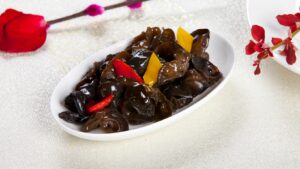Black fungus food, a culinary secret weapon, is taking the world by storm. Known for its unique texture and health benefits, it’s not just a staple in Asian cuisine anymore. This article dives deep into the world of black fungus, exploring its culinary uses and nutritional value.
From soups to stir-fries, black fungus is a versatile ingredient that can add depth and intrigue to your dishes. But it’s not just about the taste. Packed with nutrients, it’s also a powerhouse of health benefits. So, let’s embark on this gastronomic journey and unlock the secrets of black fungus food.
Black Fungus Food

Black Fungus Food, a staple in Asian cooking, comes from a family of mushrooms known as Auricularia. It’s typically grown on decaying logs or tree trunks, thriving in damp, shaded environments. The coloration ranges from amber to a deep, ink black. Apart from the color, its intriguing texture sets it apart. When dried, black fungus is tough. Hungry cooks rehydrate the fungus, resulting in a jelly-like texture, distinct and pleasing to the palate.
Black fungus outdoes the competition in both its nutritional content and health benefits. It’s packed with nutrients such as iron, boosting hemoglobin levels, reducing fatigue, and enhancing energy levels. In addition, black fungus is rich in dietary fibers, assisting in digestion, reducing the risks of heart disease, and aiding in weight control. This miraculous food also contains vitamins, like Vitamin K and B2, essential to blood clotting and the metabolic process, respectively. Not to forget, it boasts of a high amount of antioxidants, with studies showing possible ties to cancer prevention. Incorporating black fungus into one’s diet thus secures a route towards a healthier lifestyle.
Culinary Uses of Black Fungus
Black fungus doesn’t rest on its laurels as a health-boosting ingredient alone. It boasts a culinary versatility that puts it on par with more well-known mushroom varieties. Its unique jelly-like texture becomes evident upon rehydration, and its mild taste makes it an ideal addition in a myriad of dishes, ranging from traditional Asian recipes to inventive fusion dishes.
Traditional Asian Cuisine
 As per its cultural origin, black fungus shines distinctly in various Asian dishes. Owing to its ability to readily absorb flavors from the accompanying ingredients, it can elevate the complex profiles of several traditional recipes.
As per its cultural origin, black fungus shines distinctly in various Asian dishes. Owing to its ability to readily absorb flavors from the accompanying ingredients, it can elevate the complex profiles of several traditional recipes.
In Chinese cuisine, it’s a ubiquitous component of the much-loved Hot and Sour Soup – a culinary delight where its texture complements the spicy, tangy flavors. Similarly, partnering black fungus with bok choy creates a simple yet nutritious side dish that pairs well with steamed rice.
In Korean kitchens, its robust presence isn’t overlooked in Japchae, a stir-fried noodle dish teeming with vegetables. Here, black fungus lends an appealing contrast of texture to the soft silky noodles.
Modern Fusion Dishes
Black fungus isn’t confined within the bounds of traditional Asian cuisine. Contemporary culinary artists are driving its adoption into modern fusion cuisine, leveraging its texture and nutrient-rich profile to reimagine staple recipes.
Among fusion enthusiasts, black fungus salads hold a certain appeal. Marinated black fungus can be tossed with a variety of vegetables and seasoned with dressings of choice, proposing a healthful yet savory option for salad aficionados.
Finally, Deriving inspiration from Italian dishes, the cheesy Risotto gets a nutrient upgrade when black fungus makes its guest appearance. Its texture, juxtaposed with the creamy rice concoction, certainly provides a captivating, modern twist on the traditional.
How to Prepare Black Fungus for Cooking
Black fungus has indeed carved out its own niche in the global culinary scene. It’s not just its unique texture that’s catching the attention of food enthusiasts but also its impressive health benefits. With its high iron, dietary fibers, vitamins K and B2 content, it’s a nutrient powerhouse that’s hard to ignore. It’s also worth noting how black fungus is making waves in the kitchen. Its culinary versatility is showcased in traditional Asian dishes and modern fusion cuisine alike.

